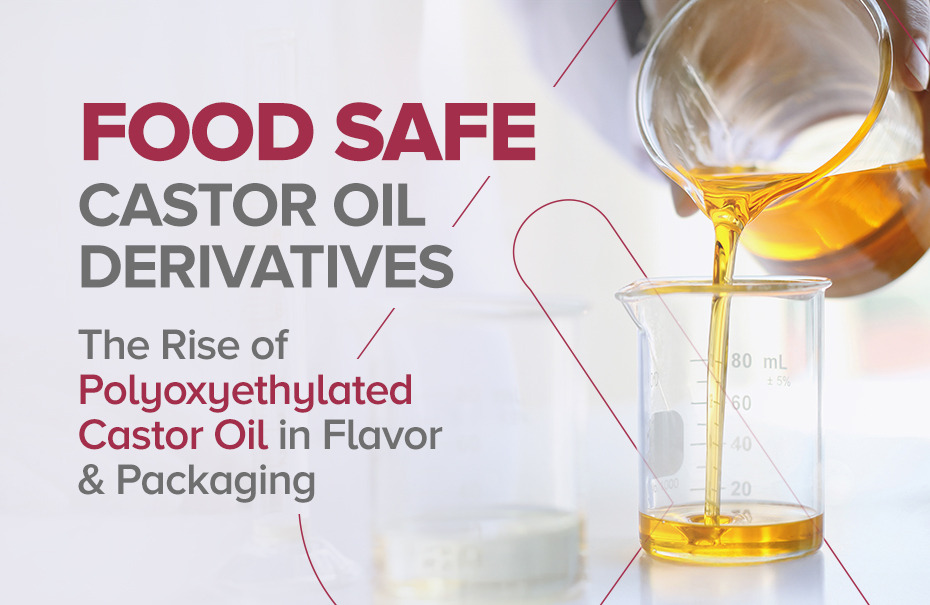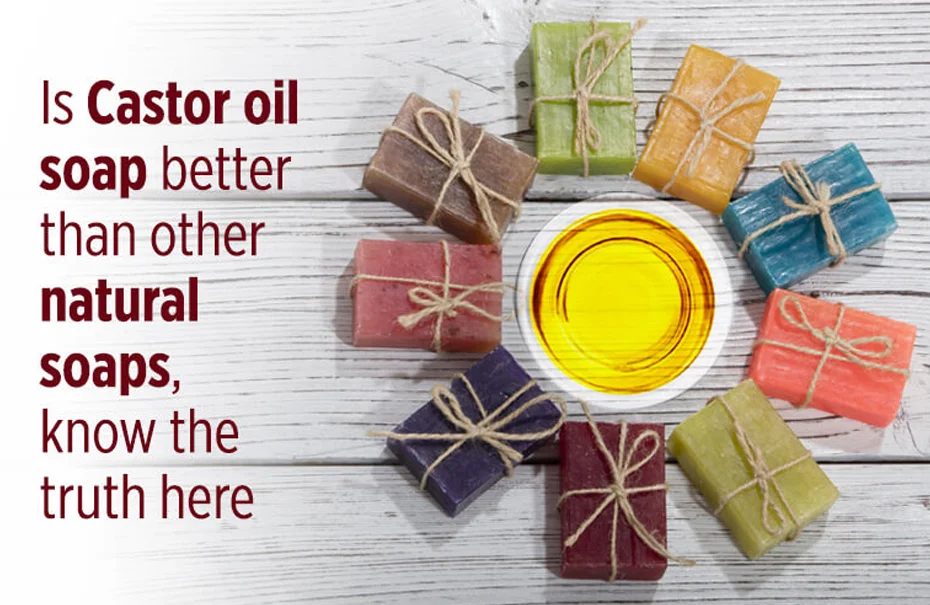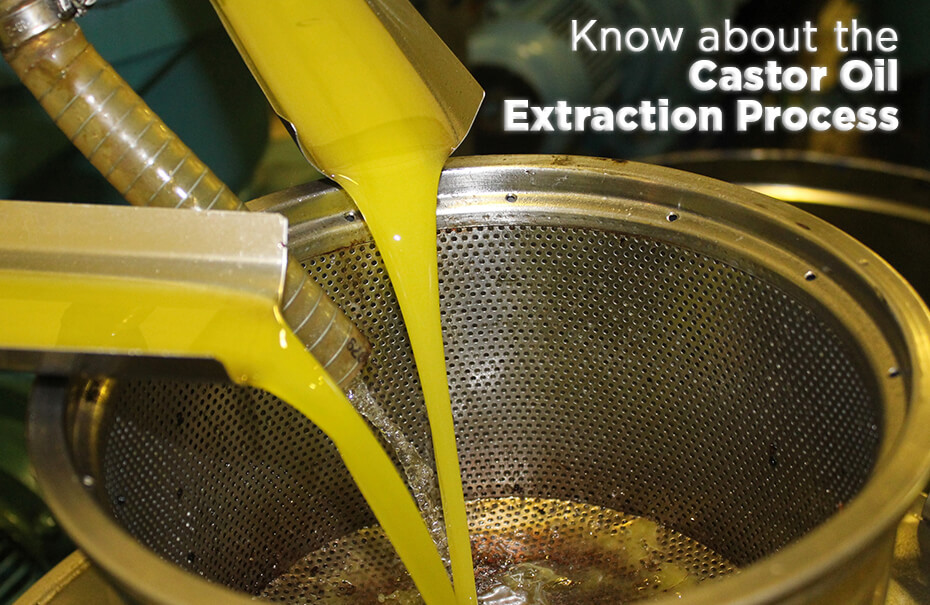Food‑Safe Castor Oil Derivatives: The Rise of Polyoxyethylated Castor Oil in Flavor & Packaging

For centuries, castor oil has been used and appreciated widely, but its contemporary potential can truly be realized through its transformation in several castor oil derivatives. The unique chemical makeup, high in ricinoleic acid, is indeed advantageous. It can be used as a versatile, renewable resource for many industries.
Polyoxyethylated castor oil derivatives are just another paramount creation among many of their innovations. This is because it has the outstanding capacity to emulsify, solubilize, and stabilize. Their qualities render them irreplaceable in applications where texture, taste, and shelf-life are key considerations.
Their role has been extended today to pharmaceutical and cosmetic use beyond just food flavors and sustainable packaging. This transition represents a larger global trend towards natural and plant-based, safe food products, which is a discipline in which castor oil derivatives manufacturers in India are making their mark in the world of responsible ingredient technology.
Let’s look at how polyoxyethylated castor oil helps enhance flavor and packaging in food products.
Why Food-Safe Castor Oil Derivatives Matter?
Castor stands out in the world of vegetable oil, and one of its food-safe derivatives, Polyoxyethylated Castor Oil, is prominent in this area of functional food-grade ingredients. It is estimated that the 2024 projection of the market value of the polyoxyethylene castor oil is USD 400 million, and to increase to USD 600 million in 2033.
They have a distinctive structure (a product of ethoxylating ricinoleic acid, a castor oil component) that gives them outstanding emulsifying and solubilizing power. The result of this transformation is a very efficient dispersion agent of hydrophobic compounds, and therefore, they find irreplaceable use in flavor, beverage, and packaging applications.
Three macro-forces are stimulating a new interest:
Complexity of flavor is on the rise. Highly scented citrus, spicy, herbal, and botanical flavors are becoming more and more popular in beverage, confectionery, and nutraceutical brands. Advanced solubilizers such as polyoxyethylated castor oil derivatives are required to achieve clarity, stability, and aroma integrity of water-based systems.
Packaging is doing more with less. Thinner films, increased recycled content, and water-based inks/coatings need to have additives that assist slip, anti-fog, pigment dispersion, and press performance, but must not affect food safety or sensory properties.
Sustainability and supply security. Castor is a non-food crop that opens up on marginal land with relatively less water requirements. The resilience and responsible sourcing narrative is becoming a strong asset for brands and can be strengthened by a robust, visible castor supply chain. This is made possible by castor oil producers in India.
So, now that you know why food-safe castor oil derivatives matter, let’s understand one of the main food-safe castor oil derivatives, polyoxyethylated castor oil.
What is Polyoxyethylated Castor Oil?
In effect, polyoxyethylated castor oil is a non-ionic surfactant whose production comprises the addition of an ethylene oxide chain (EO) to castor oil and hydrogenated castor oil. Hydrophilicity is actually decided by the quantity of EO units present. The more they are, the greater the hydrophilic-lipophilic balance (HLB) and the greater affinity to water. Practically, manufacturers provide a range of types (e.g., POE-20, POE-25, POE-40, etc.), with each type being optimized to a particular solubilization or emulsification task.
Its Important Benefits for Food and Packaging
- Ease of solubilization of flavor and fragrances. The ability to dissolve essential oils in water is useful in the development of clear solutions or fine microemulsions in beverages and syrups that require high-HLB grades.
- Taste neutrality and oxidative stability. The hydrogenated analogs are not subjected to rancidity and off-note formation, thus retaining soft top notes during shelf life.
- Thermal robustness. Applicable in the processes involving pasteurization or hot-fill, where certain emulsifiers can separate and haze.
- Compatibility. Complements lecithin, mono- and diglycerides, gum arabic, pectins, saponins, and some modified starches, giving formulators the chance to refine the mouthfeel and stability.
- Non-ionic gentleness. Less contact with charged ingredients (electrolytes, proteins) simplifies a majority of beverage systems.
Practical Note: In food, product developers may commonly blend polyoxyethylated castor oil with a clouding agent or a weighting agent (where allowed) to attain refractive index matching and help regulate ring formation, while trusting POE surfactant to do the actual solubilization.
Polyoxyethylated Castor Oil for Flavor Formulation and Stability
Maintaining a homogeneous mix of oil-soluble flavor ingredients in water-based foods is one of the major technical challenges in flavor formulation. Several natural and artificial flavors are composed of volatile, hydrophobic molecules (for example, essential oils and aromatic aldehydes), can segregate in water phases.
The lack of appropriate emulsification causes these components to get onto the surface, hence appearing as separation in visible forms or simply turning out to oxidize or lose the aromatic properties with time. This has both the effect of disrupting the sensory experience as well as decreasing the shelf life and popularity of products.
How to solve this issue? Well, with polyoxyethylated castor oil. It has a unique amphiphilic structure; one part of the molecule is hydrophobic (water-repelling), while the other is lipophilic (oil-attracting). This enables it to encapsulate in the form of mini shells (micelles) oil-based flavour molecules. When dispersion in water, these micelles are uniformly distributed, giving a clear and stable water-transparent suspension of precisely the same flavor.
- Crystal clear beverages: Perfect to use when making flavoured waters and clear carbonated beverages with no turbidity.
- Long shelf life: This is because micelle encapsulation restricts oxidation of sensitive flavor molecules.
- Unified taste delivery: The right combination of flavours is present on every serving, batch upon batch.
The flexibility of Polyoxyethylated castor oil is one of the key reasons why the product is applied to so many diverse segments of flavour-rich food:
- Functional and fortified beverages: Maintain stability of added vitamins and botanical extracts, and flavor oils.
- Flavored yogurts and dairy beverages: Precipitate flavor oil separation of protein-rich, refrigerated drinks.
- Sauces, syrups, and confectionery fillings: Maintain the uniformity of flavor in high sugar or fat products.
Polyoxyethylated castor oil plays an irreplaceable role today in the formulation of modern food and beverage products due to its capacity to provide stability, clarity, and sensory uniformity in flavors.
However, its contribution to food safety does not just fade away in the product recipe, but goes all the way down to the packaging of such a product that not only carries it but also preserves it. Let’s look at how.
Polyoxyethylated Castor Oil for Elevating Packaging
Nowadays, the need to be competitive in the food industry has transformed the packaging into much more than a container. It is now of utmost importance in ensuring freshness, shelf life, protection of senses, and increased consumer acceptance. Whether it’s fresh produce that must look visually appealing or baked goods that require moisture control, the right use of functional additives can make all the difference between a satisfied and a disappointed customer.
Role of Polyoxyethylated Castor Oil in Packaging
The polyoxyethylated castor oil imparts adaptability to food-safe packaging in some important ways:
- Anti-fogging Agent: When water or moisture is added to high-moisture food, such as fresh vegetables, salad leaves, and bakery products, condensation may obscure the visibility of packaging as well as give a less fresh appearance to products. Polyoxyethylated castor oil derivative is a surface modifier, which minimizes the formation of water droplets and makes the presentation clear.
- Slip and Processing Aid: Slip and processing aid can be used during the manufacturing of plastic films, because friction might arise between layers of the film that will lead to handling problems and wear of equipment. Polyoxyethylated castor oil is used as a slip agent, wherein smoother surfaces can be obtained, thereby increasing the efficiency of manufacturing and speed of the packaging line.
- Moisture-control Coating: In edible films and coatings used in products such as confectionery or pastries, it permits control of moisture migration, avoiding staleness and sugar-bloom effects and preserving texture.
Furthermore, where the safety of contact with food is involved, regulatory compliance is not optional. When produced under food-grade conditions, polyoxyethylated castor oil passes very stringent migration limits, which include those established by the U.S. FDA, EFSA, and FSSAI.
This makes it an apt option to be used by the packaging engineers who require performance not in jeopardizing safety. The compatibility, safety, and functionality make it a powerful tool in the design of the kind of packaging that works harder today, given the demanding food supply chains.
Conclusion
Castor Oil derivatives, like Polyoxyethylated castor oil, are a perfect balance of safety, functionality, and sustainability. They reflect a larger food landscape where consumers want their food to have safe flavors and packaging, a move to clean-label, renewable sources, and performance ingredients.
India being at the epicentre, the castor oil derviatives manufacturers in India, Ambuja Solvex, can help in this transformation by providing castor oil derivatives that benefit all the industries, consumers, and the world itself. Combining efficiency through nature and innovation, we are well poised to establish the next-generation food and packaging solutions. By integrating the efficiency of nature combined with innovation, we create a new generation of food and packaging systems.
Looking for an effective ingredient to enhance your food flavors and packaging? Contact now! |
FAQs
- How is polyoxyethylated castor oil used in foods?
It is primarily used as a non-toxic emulsifier and solubilizing agent of fat-soluble vitamins, essential oils, and flavors, which provides food stability and consistency of the texture.
- Do the castor oil derivatives have safety for food contact use?
Yes. Most derivatives are used within the regulations GRAS (Generally Recognized As Safe) on a global food safety basis, such as polyoxyethylated castor oil.
- What role do derivatives of castor oils play in food packaging?
Their properties as anti-stick agents, mold inhibitors, and surface protectants allow them to keep the shape and integrity of the product intact, as well as be in line with the requirements of food-contact safety.
- How come India is leading in the production of Castor oil derivatives?
India has a majority of castor oil producers, raw material supply, high-level processing facilities, and knowledge of the manufacture of high-value derivatives.



